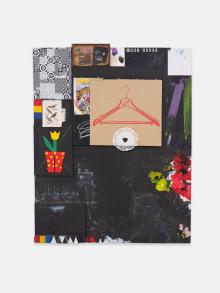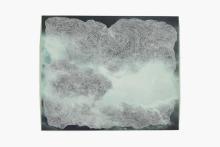Back
Drawing Connections: Raymond Saunders with Laura Vandenburgh
Raymond Saunders (American, b. 1934)
Untitled, n.d.
Mixed media on plywood, 60-1/4 x 48-1/8 in.
Museum purchase with funds from the Edna Pearl Horton Memorial Endowment Fund, the Hartz FUNd, and the Museum Director's Fund; 2021:18.1
Laura Vandenburgh (American, b. 1963)
Shimmer I, 2021
Inkjet print, ink, paper, 20-3/4 x 25 in.
Courtesy of the artist (Photography by Camilla Dussinger)
Drawing Connections: Raymond Saunders with Laura Vandenburgh
April 23, 2022 to December 18, 2022
The JSMA’s recent acquisition of Untitled by Raymond Saunders (American, b. 1934) marked the first work by this esteemed Bay Area painter and installation artist to enter the collection. Untitled combines many of the visual and thematic elements Saunders has repeated throughout his long artistic career. His work often references his public school education in Pittsburgh and his own role as an educator: as professor (now emeritus) at California State University in Hayward (now CSU East Bay) and as a core faculty member at the California College of Arts, from which he had received his MFA in 1961. Saunders was awarded a Rome Prize Fellowship (1964), a Guggenheim Fellowship (1976), and two National Endowment for the Arts Awards (1977, 1984). His 1967 pamphlet titled “Black Is a Color” challenged the notion of “Black art” as an identifiable, fixed category of art-making tied directly to an artist’s racial identity. In Saunders’ rejection of an easy reading of his own works, he celebrates the possibilities provided by jazz-like improvisation, multiple references, and layered meanings.
Untitled is presented in context with special loans of three drawings by Saunders from the collection of Laura Vandenburgh (Director, UO School of Art + Design; Associate Dean; and Professor of Art), and two works from Vandenburgh’s own drawing-based practice. The two artists have known one another for nearly five decades; Drawing Connections includes a reflection from Vandenburgh on the significance of this friendship and Saunders’ role in the development of her own artistic practice.







